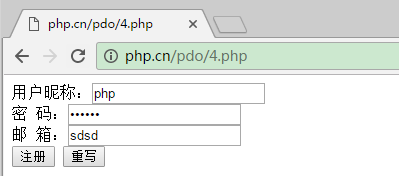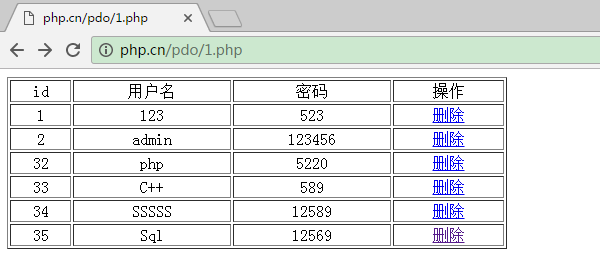
PDO::prepare — Prepare the SQL statement to be executed and return a PDOStatement object (PHP 5 >= 5.1.0, PECL pdo >= 0.1.0) Description syntax public PDOStatement PDO::prepare ( string $statement [, array $driver_options = array() ]) Prepare the SQL statement to be executed for the PDOStatement::execute() method. The SQL statement can contain zero or more named (:name) or question mark (?) parameter markers. The parameters are in SQL will be replaced when executed. You cannot include both named (:name) or question mark (?) parameter markers in an SQL statement; you can only choose one of these styles. The parameters in the preprocessed SQL statement are using PDOSt
1. mysql PDO::prepare usage details

Introduction: PDO::prepare — Prepare the SQL statement to be executed and return a PDOStatement object (PHP 5 >= 5.1.0, PECL pdo >= 0.1.0) Description Syntax public PDOStatement PDO::prepare ( string $statement [, array $driver_options = array() ] )
2. Call the constructor in multiple ways to create a PDO object

Introduction: The construction method can be adjusted in various ways to create PDO objects. The following is to connect MySQL and Oracle servers. For example, we will introduce the various calling methods of the constructor method.
3. Detailed introduction to stored procedures in PDO

Introduction: Stored procedures in PDO allow data to be manipulated closer to the data, thereby reducing bandwidth usage. They make the data independent of script logic, allowing multiple systems using different languages to access the data in the same way. , thus saving valuable time spent on coding and debugging. At the same time, it uses predefined solutions to perform operations, improves query speed, and prevents direct interaction with data, thus protecting the data!
4. Detailed introduction to transaction processing in PDO

##Introduction: A transaction is composed of a sequence of query and/or update statements. Use begin and start transaction to start a transaction, rollback to roll back the transaction, and commit to commit the transaction. After starting a transaction, there can be several SQL queries or update statements. After each SQL is submitted for execution, there should also be statements to determine whether it is executed correctly to determine whether to roll back in the next step. If all are executed correctly, the transaction is finally committed. Once a transaction is rolled back, the database remains in the state it was in before the transaction started. It is like if an edited file is exited without saving, the original appearance of the file will be retained. Therefore, a transaction can be regarded as an atomic operation, and the SQL in the transaction is either full
5. Error handling method two in PDO - errorInfo() method

Introduction: PDOStatement::errorInfo — Get extended error information related to the last statement handle operation (PHP 5 > = 5.1.0, PECL pdo >= 0.1.0)!
6. Error handling method 1 in PDO - errorCode() method

Introduction: There are two methods in PDO to obtain error information in the program: errorCode() method and errorInfo() method! So in the next article, we will introduce these two methods to you one by one!
7. Use exception mode-PDO::ERRMODE_EXCEPTION (Capturing errors in SQL statements in PDO three)

Introduction: Exception mode will create a PDOException and set the erorCode attribute. It can encapsulate the execution code into a try{...}catch{...} statement. Uncaught exceptions will cause The script breaks and a stack trace is displayed to let the user understand where the problem occurred!
8. Use warning mode-PDO::ERRMODE_WARNING (Method 2 for capturing errors in SQL statements in PDO)

Introduction: Warning mode will generate a PHP warning and set the errorCode attribute. If warning mode is set, then unless the error code is explicitly checked, the program will will continue to function the way it does.
9. Use the default mode-PDO::ERRMODE_SILENT (Method 1 to capture errors in SQL statements in PDO)

Introduction: There are three options to choose from to capture SQL statement errors in PDO. Choose the appropriate solution to capture SQL statement errors according to your own development project and actual situation. !
10. Detailed explanation of the fetchColumn() method for obtaining the result set in PDO

Introduction: The fetchCloumn() method obtains the value of the specified column in the next row in the result set and returns a single column from the next row in the result set.
[Related Q&A Recommendations]:
The data int type queried by pdo and thinkphp is also String. Do other frameworks do the same?
python - How to encode only the Chinese in the url
#php - Why is the database empty after I insert html tags into the database?
The above is the detailed content of 10 recommended articles about php pdo. For more information, please follow other related articles on the PHP Chinese website!




